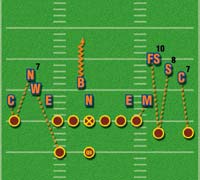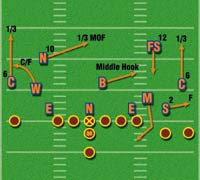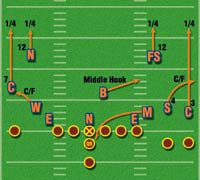Keeping Drives Alive: Effective Third Down Game Planning
\'Efficient is doing the job right. Effective is doing the right job.\'
©
More from this issue
At Western Michigan University, we utilize a multi-faceted approach
when it comes time to game plan third down. It is a cooperative
effort, involving all of the members of the offensive staff and
the head coach.
Before any meaningful discussion on third downs takes place, you must develop
the down and distance parameters that will guide you through your game planning.
We have two general categories, run situation and pass situation. We’ll
game plan two run situations for third down: 3rd/1 and 3rd/2-3. Our third down
pass situation game plan has the following: 3rd/4-6, 3rd/7-10, 3rd 11-15, and
3rd 16+.
One of the ways that Gary Darnell, WMU’s Head Coach, requires our staff
to measure 3rd down effectiveness is through the use of quality control (QC).
Quality Control is a detailed list of criteria that has a corresponding performance
objective. These objectives are Reasonable, Outstanding, and Championship. For
example, the Reasonable Objective for 3rd/3-5 is a 50% conversion percentage,
the Outstanding Objective is 52%, and the Championship Objective is 54%. Our
performance is checked against these objectives weekly, and are a constant source
of feedback throughout the season.

Diagram 1A.
• FC Aligns I.S. on #1 (has no
help)
• SAM aligns O.S. on #2 (has I.S. help)
• FS aligns I.S. #2

Diagram 1B.
• FS aligns on widespread hash
•
SAM aligned O.S. shoulder of #2
•
WILL aligned over ghost TE into boundary

Diagram 1C.
|
Each coach has a specified list of tasks, and it is his responsibility
to be an “expert” in his assigned area. The offensive
coordinator oversees all of the elements needed for effective third
down game planning. He insures
that the QC, self-scout, opponent computer report, opponent scouting report
sections, and video cut-ups are completed in a timely fashion.
The running backs coach
draws up the expected 3rd down run situation defenses. The offensive line coach
draws up the expected 3rd down pass situation fronts, stunts, and blitzes.
The quarterback coach draws up the coverage that the defense uses
by 3rd down situation
against the formations that we may utilize in our game plan. (See Diagrams
1A-1C: Against Central Michigan last year, various 3rd down alternatives.)
The TE coach’s job is to analyze defensive personnel. He must find the
answers to the following questions: Does our opponent sub by down and distance
or by offensive personnel? If they sub by down and distance, what are the “breaking
points” when the defense will switch from their base personnel to substitute
packages? Who goes in and who comes out in their run situation Heavy and Goal
line packages? Who goes in and who comes out in their pass situation Nickel
and Dime packages? What player(s) can we exploit with a possible mismatch in
each
of these personnel packages? Is there a mismatch our opponent can capitalize
on if we are not careful?
Preparation for third downs begins on the Thursday of the week prior to the game.
That is when our Offensive Graduate Assistant starts his breakdown of opponent
film. When the breakdown is complete, he passes along the take-off sheets to
our Video Assistant, who inputs the information into the computer. Our computer
reports are run on Sunday evening, after our next opponents Saturday game is
broken down and inputted.
Our third down study begins on Monday. The first order of business is to look
inward by studying our Third Down Quality Control report. The next piece of
information that is analyzed is our self-scout. Our self-scout alerts us to
any tendencies
that we may be “sharing” with our opponent, and allows us to correct
them before we put our 3rd down plan together.
One of our keys to success is having a set number of plays per strategy situation.
We annually study the number of plays we average per game in a given situation.
We then game plan that amount, plus one or two more plays. The addition of the
extra plays per strategy situation covers us in case there are more plays than
normal for that particular down and distance. By following our formula, we practice
the right amount of plays that we will need in a game, and not waste valuable
repetitions on plays that will lie unused on game day.
We start analyzing our opponent’s third down defenses at 6:30 AM on Tuesday
morning. Required tools are the video cut-ups of the opponents 3rd down defenses,
computer reports, scouting reports, and a third down board. On the third down
board, there are six strategic situations that we game plan for. Under each
situation, there is a numbered list of lines. The number of lines will vary
by strategy
situation, according to the frequency of that particular situation occurring
in a game. (See
Diagram 2: 3rd Down Board)
As we work through each situation, the offensive coordinator puts up suggested
plays on the list. Once the list is filled, we are finished with game planning
that situation. If someone comes up with a better idea later on, a play must
come off of the list in order for the new play to go on. We are always striving
to maintain a certain pass / run ratio per situation, but by no means do we lock
ourselves into that ratio.
We install and practice our third down game plan on Wednesday, and review it
again in its’ entirety on Thursday. After watching Wednesday’s
practice tape, we will rank the plays on our list in order of preference.
The last thing we do with the third down game plan before we “etch it in
stone” is to go over it with our quarterbacks. We want them to have the
utmost confidence in their ability to execute the plan. After consulting with
them, we may re-order our list one more time, and occasionally drop a play from
the game plan. The QB’s can also request to have any of the third down
plays reviewed during our Friday walk-through.
Effective third down play calling doesn’t “just happen” under
stress, thus the necessity for a well thought out list. This list then is copied
to our game plan sheet.
On third downs, as in life, “it’s better to look ahead and prepare,
than look back and regret.”
About the author
Charley Molnar
Charley Molnar enters his second season this fall as Quarterbacks Coach at
Western Michigan. A 20 year veteran of coaching on the collegiate level, Molnar
has coached at Eastern Michigan, Eastern Illinois, Kent State, Illinois State,
Western Carolina and Virginia. He began his coaching career at his alma mater,
Lock Haven, starting in 1984. You can reach him at Charley.Molnar@wmich.edu








